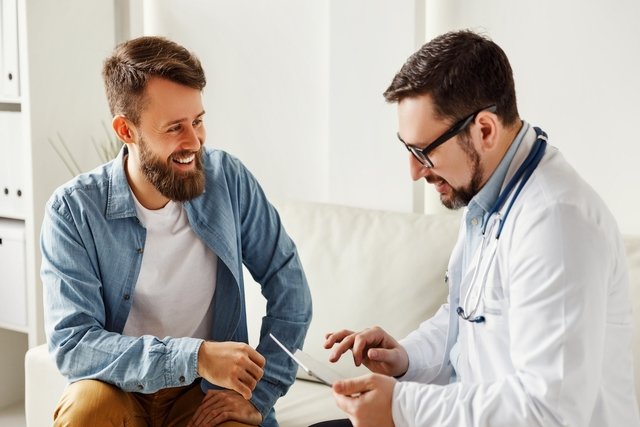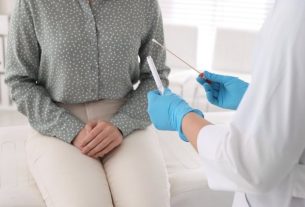Male gonorrhea is a sexually transmitted infection (STI) caused by the bacteria Neisseria gonorrhoeae, which is mainly transmitted through unprotected sexual intercourse.
The first indicative sign of gonorrhea is inflammation in the urethra, which leads to the appearance of light-colored discharge that becomes darker over time, and there may also be a sensation of pain and burning when urinating.
It is important that in the presence of signs and symptoms indicative of male gonorrhea, the man goes to the urologist to confirm the diagnosis and initiate the most appropriate treatment, which involves the use of antibiotics, thus preventing the development of complications, such as infertility. Learn more about gonorrhea.

Symptoms of male gonorrhea
The main symptoms that may indicate male gonorrhea are:
- Pain and burning when urinating;
- Low fever;
- Inflammation of the urethra;
- Yellowish-white secretion, similar to pus, that comes out of the urethra;
- Frequent urge to urinate;
- Inflammation in the anus, if there has been unprotected anal intercourse;
- Sore throat, if oral sexual intercourse has occurred.
In general, symptoms of male gonorrhea usually appear 2 to 10 days after contact with the bacteria responsible for the infection. Know how to identify all the symptoms of gonorrhea.
It is important for men to be aware of the appearance of these symptoms, as this means that appropriate treatment can be initiated and the transmission of the bacteria to another person can be avoided.
Online symptom test
To find out if you have gonorrhea, please select the symptoms you present:
This test is a tool that serves as a means of guidance only. Therefore, it is not intended to provide a diagnosis and does not replace consultation with an infectious disease specialist, gynecologist or urologist.
How the diagnosis is made
The diagnosis of gonorrhea is made by the urologist according to the signs and symptoms presented by the man and by analyzing the secretion released from the urethra.
Make an appointment with a urologist in the region closest to you:
Taking care of your health has never been easier!
This secretion is sent to the laboratory to be processed and tests to identify the bacteria.
How the treatment is carried out
Treatment for male gonorrhea must be indicated by a urologist, and the use of antibiotics is normally recommended, which must be used according to instructions, even if there are no more symptoms.
Furthermore, it is important that the treatment is also carried out by the partner, as this makes it possible to avoid contagion again. Learn more about the treatment of gonorrhea.
One way to complement antibiotic treatment is to use some home remedies that have antimicrobial properties and help alleviate symptoms, and it is important that they are recommended by your doctor. Discover some home remedy options for gonorrhea.
Is there a cure for male gonorrhea?
Gonorrhea is curable as long as antibiotic treatment is carried out according to the doctor’s instructions.
It is important that the treatment is carried out until the end, even if there are no apparent signs and symptoms, as this will ensure the elimination of the bacteria, prevent the resistance of this infectious agent and prevent the development of complications, such as infertility.
Read too: How long does it take to cure gonorrhea?

Bibliography
- MORGAN, Mackenzie K.; DECKER, Catherine F. Gonorrhea. Disease-a-Month. Vol.62(8). 260-268, 2016
- PAPADAKIS, Maxine A.; MCPHEE, Stephen J.; RABOW, Michael W. Current Medical Diagnosis & Treatment 2019. 58th. NEW YORK: McGraw-Hill Education, 2019.
- BOSTON PUBLIC HEALTH COMMISSION. Gonorrhea. 2018. Disponível em: <https://bphc.org/whatwedo/infectious-diseases/Infectious-Diseases-A-to-Z/Documents/Fact%20Sheet%20Languages/Gonorrhea/Portuguese.pdf>. Acesso em 17 mar 2020
- BRAZILIAN SOCIETY OF INFECTOLOGY. Gonorrhea. Available at: <https://www.infectologia.org.br/pg/986/gonorreia>. Accessed on March 17, 2020
- BARRER, Michael R et al. Medical Microbiology: A guide to microbial infections – pathogenesis, immunity, laboratory investigation and control. 19 ed. Elsevier, 2018. 264-266.

Sign up for our newsletter and stay up to date with exclusive news
that can transform your routine!
Warning: Undefined array key "title" in /home/storelat/public_html/wp-content/plugins/link-whisper-premium/templates/frontend/related-posts.php on line 12
Warning: Undefined array key "title_tag" in /home/storelat/public_html/wp-content/plugins/link-whisper-premium/templates/frontend/related-posts.php on line 13



